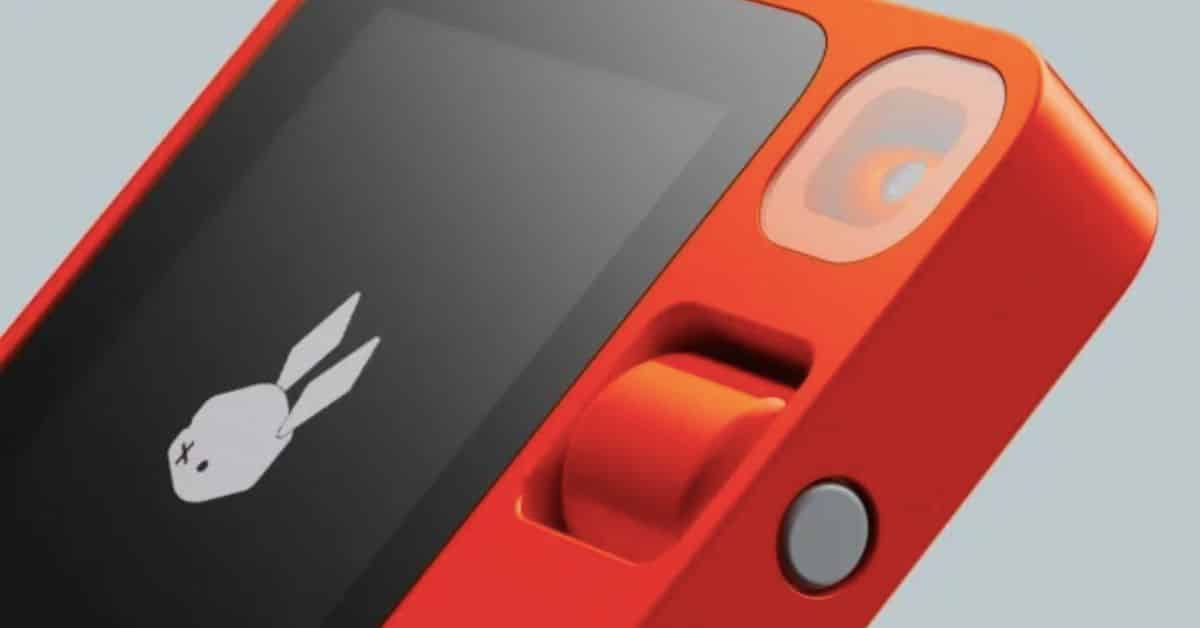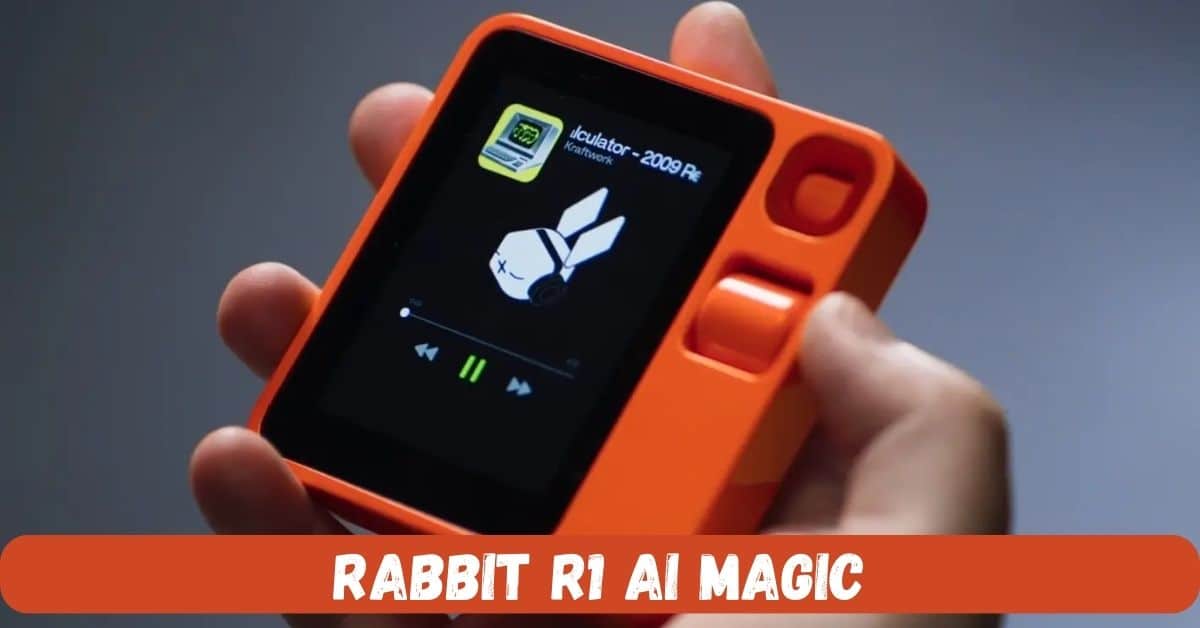Rabbit R1 AI Magic: Despite claims to the contrary, Rabbit’s CEO and founder, Jesse Lyu, is not interested on displacing your smartphone. Certainly not immediately. The R1, his new $199 standalone AI gizmo, is so ambitious that Lyu appears to believe he will eventually replace your phone. Only not quite there yet.
Similar to a Playdate console or an updated version of those portable TVs from the 90s, the R1 has a rather retro design. A 2.88-inch touchscreen, a rotating camera for photo and video capture, and a scroll wheel / button for navigating the device or speaking to its built-in assistant are all features of this standalone device, which is about half the size of an iPhone.
A 2.3GHz MediaTek processor, 4GB of RAM, and 128GB of storage are housed in a spherical, Teenage Engineering–designed body. Regarding the battery, Rabbit simply states that it lasts “all day.” After Rabbit’s launch event, I got to play around with the R1, and I have to say, the hardware is top-notch.

Because the hotel’s Wi-Fi was so unstable, not a single gadget worked, not even Lyu’s. However, in person, the R1 is noticeably lighter and more pleasant to the touch than it appears in photographs. As expected from Teenage Engineering, the buttons are satisfyingly clicky, and the whole design fits well in my hand. Still, it seems to attract fingerprints like crazy.
What makes the R1 special is its software, specifically Rabbit’s operating system (Rabbit OS) and the underlying artificial intelligence technology. “Rabbit OS is based on a Large Action Model,” rather than a ChatGPT-like large language model; the best way I can explain it is as a kind of universal controller for apps.
“We wanted to find a universal solution just like large language models,” he explains. “What do you think about the idea of a universal solution that would activate our services on any platform, be it a desktop, an app, or a website?” Essentially, it’s the same concept as Google Assistant or Alexa.
With Rabbit OS, you can manage your music, book a ride, shop for groceries, send messages, and more—all from a unified interface. Say what you want, and the gadget will give it to you; no more juggling logins and apps.
Lyu claims that the primary purpose of the R1’s screen is to allow users to independently validate the model’s output; the interface will consist of a deck of cards organized by category, such as those for music, transportation, and video chats.
Rabbit trained its model on how to use current apps for itself instead of building a bunch of APIs and trying to convince developers to use the R1. To train the massive action model (LAM), users demonstrated the inner workings of popular apps by engaging with them, such as Spotify and Uber.
I’m happy to see that Rabbit sold out of their first production run. Innovation should be rewarded and these folks took risks. hardware is hard and I hope they succeed. https://t.co/GueikT8xfJ
— Paul Brody prbrody.eth 🦇🔊 (@pbrody) January 12, 2024
A few things the LAM picked up were the location of the search bars, the appearance of the Settings icon, and how to recognize the confirmation of a purchase. That, according to Lyu, is universally applicable to all apps. The R1 also includes a training mode where you can instruct the device to accomplish a certain task; from then on, it should be able to carry out the task autonomously.
“Hey, first of all, go to a software called Photoshop,” Lyu says as an example. Crack it open. All of your images may be found here. Grab the watermark with a lasso and click, click, click. Here is the process for removing a watermark: In 30 seconds, Rabbit OS will process, according to Lyu, and after that, it will be able to automatically remove all of your watermarks.
The true mystery, though, is how everything functions in reality. There are a few things you can do on the R1, and there’s a web portal called Rabbit Hole that you can use to access all your services.
showcased at #CES2024/@CES, @rabbit_hmi's r1 is an #AI touchscreen device that can execute tasks of smartphone apps 📱 https://t.co/r0FC2IavTK
— designboom (@designboom) January 11, 2024
In addition, you won’t need to utilize your own equipment or software to teach the gadget new skills; for example, you can use one of Rabbit’s virtual machines to teach it Photoshop. However, it will be challenging to get that to operate correctly with many users on many devices and platforms.
Here, Rabbit’s strategy is really astute. The LAM method circumvents the difficulty of convincing anyone, including IT giants, to adopt a new OS by merely instructing the model in the use of applications. On a broader scale, there is an avalanche of new AI-powered devices hitting the market, but unfortunately, most of these devices simply link up with chatbots.
Wow.
The R1, the $199 pocket-sized AI gadget from @rabbit_hmi sold (out) 10k units in one day.
Announced at #CES2024, the AI handheld based on a "large action model" will ship second batch orders in April to May 2024.https://t.co/fbG23T86Eh
— Brian Solis (@briansolis) January 11, 2024
In comparison, Rabbit is more akin to a super app, with a singular interface that allows you to accomplish nearly anything. Rabbit OS is like ChatGPT for app stores, but for web searches. That dream is intriguing, but there are a thousand things that could go wrong with it.
It is unclear from Lyu’s explanations about Rabbit OS and the R1 what the business intends for this gadget. It has a SIM card port and can conduct video calls, but it isn’t powerful enough to replace your phone. The device’s screen and camera complement its voice assistant functionality.
The new r1 from @rabbit_hmi is changing the AI game. The device, which integrates a MediaTek chip, has a revolutionary natural-language operating system that navigates apps quickly and efficiently on your behalf so you can get more done. https://t.co/PQ8ro9aQhh pic.twitter.com/sbFWb2YOrG
— MediaTek (@MediaTek) January 12, 2024
It’s more than simply a voice assistant—it performs a veritable laundry list of voice assistant functions. Rabbit claims it has built Rabbit OS with privacy and security in mind, although it has its own login screens for your most-used services. Lyu thinks the R1 is the future of everything and also a cool accessory.
You can preorder the R1 right now, and according to Lyu, you can expect to start receiving yours in March. He goes so far as to consider (and perhaps even hope) that he can outsell Humane’s AI Pin.
You can check our recent posts related to technology:



